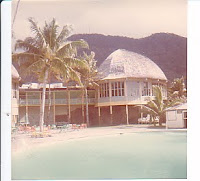I have started to add pix from the late 1970's/early 1980's when we were
contracted to manage the implmentation of the grant. Just scroll on down.
Back in the mid-1970’s, along with two partners, I formed Action Resources, Inc.,(ARI) based in Honolulu, Hawaii . I was President, CEO and Chairman of the Board and my partners were the VP’s.
All three partners had been formerly employed at Pacific Analysis Corporation, also of Honolulu, where I was Executive Vice President and my partners were Senior Analysts conducting operation and systems analysis on Naval contracts. All three of us wanted to expand into private enterprise commercial work and local government consulting while the owners of PAC wished to focus only on military work and thus we pulled away and formed our own entity.
The U.S. Congress enacted the National Energy Conservation Policy Act of 1978, which in part, created grants for each state and all the territorial possessions of the U.S. to form a continuing program to implement conservation techniques through public awareness campaigns. As this was new field, almost none of the state and territorial governments possessed on-board talent to draft the grant application required to be completed in order to receive the grants. At ARI we had sufficient expertise to bid for the grant writing of the State of Hawaii’s application for the funding of Energy Conservation and Public Awareness grant unde the above cited act.. We won request for proposals issued by the state and subsequently were successful in writing the grant which was awarded to Hawaii in the sum of approximately $2 million (1979 dollars). ARI was subsequently contracted to implement the grant while searching for candidates to fill state governmental positions to continue the implementation of the grant.
The Territory of American Samoa also qualified for grant funds under this act if they could produce an acceptable grant application to Washington D.C. They had used two different consulting firms who attempted to draft the grant application but each failed to produce an acceptable product. The deadline to submit a successful grant application was approaching the expiration date when they leaned that we had been successful in drafting Hawaii’s grant and thus they contacted us to see if we could help them. We responded that we thought we could and advised the Governor’s office that we could send our team down for an estimated initial cost of about $6,000 (1979 dollars) to commence the initial draft. They replied saying they did not have that kind of money on hand but they would find it later to reimburse our expenses. We negotiated over a couple of days with the Governor’s office but upfront money for us would not be available. If we wanted to attempt the grant application using our own money they promised to find a way to reimburse us at a later date. My partners and I agreed that we would take the risk of completing the grant application on their terms.
The Rainmaker Hotel is set alongside a small beach overlooking Pago Pago Harbor. The hotel offered standard rooms and bungalows for guests, had a restaurant with full bar, a neat swim pool and deck and fabulous small beach area looking out at the mouth of the bay. It was built in the 1960's; The hotel had a long wing of standard hotel rooms running west from the main lobby area and towards the stairwell across the road that lead up to the Governor’s mansion. It is here in nthis wing of the hotel that we established the first Territory Energy Office (TEO). Pictured below from left to right are AS Gov't rep High Chief Brownie Tuiasosopo,and then ARI exec's Jim Merrill and John Olney.

In the photo's below you will see how thr Rainmaker looked when were routinely visiting and working on the Energy projects in Pago Pago.



Today, photographs show that the hotel in a complete state of degredation caused by the decision to not repair the facility. Scavangers have had their way with the rooms. There are doors hanging off hinges, broken roof slates sliding off the roof and laying broken on the ground and pool formerly green from algae is cracked and chipped.
Below are the principal facts about the complex which the government hopes to lease to entrepreneurs.
(Extracted from the government’s Web site info is couple years old)
Subject Property: The Rainmaker
Hotel, Utulei Village, Island of Tutuila, U.S. Territory of American Samoa.
Geographic Location: In the South Pacific, 14 deg. South, 170 deg. West approximately 2,300 miles SW of Hawaii and 1,800 miles NE of New Zealand
Land Area: 5.03 acres
Improvements: Rainmaker Hotel including 140 guest
rooms in two attached buildings plus detached fale
(cottages) as well as
related improvements.
Age: Thirty to forty (30-40) years
Condition:
Unfurnished, unoccupied, and in disrepair; requires major renovation or to be
razed and rebuilt
Utilities: All major public utilities serve the property
Fee Owner: American Samoa Government
Leasehold Owner: American Samoa
Development Corporation
Zoning: H, Hotel
Offering Price
The American Samoa Development Corporation (ASDC) wishes to lease the Rainmaker Hotel property at a minimum lease rate of twenty five thousand dollars ($25,000.00) and 2.5% of gross revenues per month up to year 2050 on an “as is” basis. The investors can utilize the property for hotel or any other suitable commercial purpose with prior concurrence from ASDC.

No comments:
Post a Comment